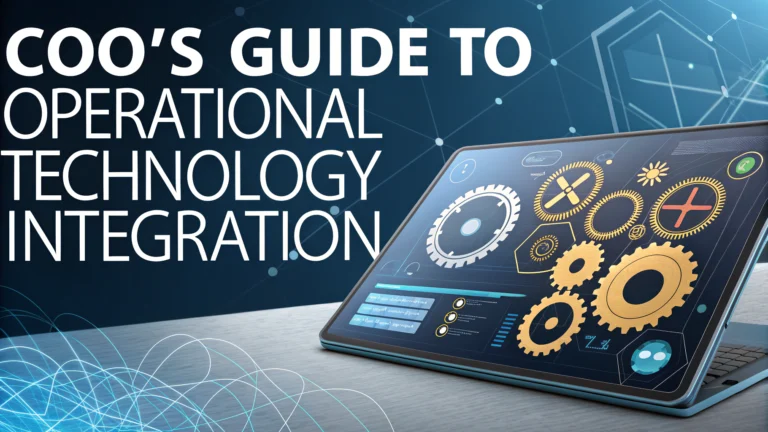Operational technology (OT) integration presents unique challenges for Chief Operating Officers managing industrial control systems, manufacturing processes, and critical infrastructure.
A successful OT integration strategy requires careful consideration of security, legacy systems compatibility, and minimal disruption to existing operations.
This guide outlines practical steps for COOs to implement effective OT integration while maintaining operational continuity and maximizing ROI.
Key Components of OT Integration
- Industrial Control Systems (ICS)
- Supervisory Control and Data Acquisition (SCADA)
- Programmable Logic Controllers (PLCs)
- Human-Machine Interfaces (HMI)
- Industrial Internet of Things (IIoT) devices
Security Considerations
Implement network segmentation to isolate OT systems from IT networks using firewalls and DMZs.
Deploy industrial-grade security solutions specifically designed for OT environments.
Establish regular security audits and vulnerability assessments focused on OT infrastructure.
Legacy System Integration
- Conduct thorough system audits
- Implement middleware solutions for compatibility
- Consider gradual migration strategies
- Maintain documentation of legacy protocols
Risk Management Strategy
| Risk Category | Mitigation Strategy |
|---|---|
| System Downtime | Redundant systems, backup procedures |
| Security Breaches | Access controls, monitoring systems |
| Data Loss | Regular backups, disaster recovery plans |
Implementation Timeline
- Assessment Phase (1-2 months): System audit and requirements gathering
- Planning Phase (2-3 months): Strategy development and vendor selection
- Implementation Phase (3-6 months): Staged rollout and testing
- Optimization Phase (Ongoing): Monitoring and improvements
Vendor Selection Criteria
- Experience with similar OT environments
- Support for industry-specific protocols
- Security certification compliance
- 24/7 technical support availability
- Clear upgrade and maintenance paths
Cost Considerations
Budget for both initial implementation costs and ongoing maintenance expenses.
Consider TCO (Total Cost of Ownership) including training, support, and upgrades.
Plan for contingency funds (15-20% of project budget) to address unexpected challenges.
Training Requirements
- Operator training on new systems
- Security awareness programs
- Maintenance procedures training
- Emergency response protocols
Moving Forward with OT Integration
Regular assessment of integration effectiveness through defined KPIs and metrics.
Maintain open communication channels between IT and OT teams.
Contact industry organizations like ISA (International Society of Automation) at www.isa.org for additional resources and support.
Performance Monitoring
Establish clear metrics and KPIs to measure integration success:
- System uptime and reliability rates
- Response times for critical operations
- Security incident frequency
- Cost savings and efficiency gains
- Production output metrics
Compliance and Standards
Ensure adherence to relevant industry standards and regulations:
- IEC 62443 for industrial automation
- NIST Framework for critical infrastructure
- Industry-specific compliance requirements
- Regional data protection regulations
Change Management
Stakeholder Communication
- Regular updates to management and operators
- Clear documentation of changes and impacts
- Feedback mechanisms for system users
- Progress reporting to executive leadership
Process Adaptation
- Updated standard operating procedures
- Revised maintenance schedules
- Modified emergency response plans
- New quality control processes
Securing Long-term OT Success
Maintain a proactive approach to system maintenance and updates.
Foster collaboration between IT and OT teams for continued innovation.
Build resilient systems that can adapt to future technological changes.
Develop a culture of continuous improvement and security awareness.
| Success Factor | Key Actions |
|---|---|
| System Reliability | Regular maintenance, proactive monitoring |
| Team Capability | Ongoing training, skill development |
| Future Readiness | Technology roadmap, scalable solutions |
FAQs
- What is Operational Technology (OT) and how does it differ from Information Technology (IT)?
Operational Technology is hardware and software that monitors and controls physical devices, processes, and infrastructure in industrial settings. Unlike IT, which focuses on data and information systems, OT directly interfaces with physical equipment and industrial processes. - What are the key components of an OT integration strategy?
Key components include security frameworks, network architecture, data collection systems, control systems, physical asset integration, workforce training, risk assessment protocols, and compliance management systems. - How can COOs ensure cybersecurity in OT environments?
COOs should implement air-gapped networks where possible, utilize industrial firewalls, conduct regular security audits, maintain updated firmware, enforce access controls, and establish incident response protocols specific to OT systems. - What are the main challenges in integrating legacy OT systems with modern technology?
Common challenges include outdated protocols, lack of standardization, security vulnerabilities, limited connectivity options, proprietary systems, and the need for specialized expertise in both old and new technologies. - How does OT integration impact operational efficiency?
OT integration enables real-time monitoring, predictive maintenance, automated process optimization, reduced downtime, improved asset utilization, and enhanced data-driven decision making. - What regulatory compliance considerations are important for OT integration?
Key considerations include NIST frameworks, IEC 62443 standards, industry-specific regulations (like NERC CIP for energy), data privacy laws, safety standards, and environmental compliance requirements. - How should COOs approach OT-IT convergence?
COOs should focus on creating cross-functional teams, establishing clear governance structures, developing unified security policies, implementing compatible communication protocols, and ensuring seamless data flow between OT and IT systems. - What ROI metrics should COOs track for OT integration projects?
Important metrics include reduction in operational costs, decreased system downtime, improved production efficiency, maintenance cost savings, energy consumption reduction, safety incident reduction, and time-to-market improvements. - How can COOs ensure successful change management during OT integration?
Success requires clear communication plans, comprehensive training programs, phased implementation approaches, stakeholder engagement, risk mitigation strategies, and continuous feedback loops from operational staff. - What are the essential considerations for OT vendor selection?
Key factors include vendor expertise in your industry, long-term viability, support capabilities, integration experience, security track record, compliance with industry standards, and total cost of ownership.
